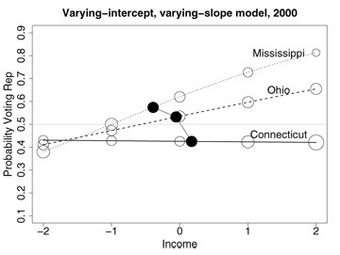Research Shatters Voting Pattern Stereotypes

New research by Andrew Gelman, professor of statistics and political science, reveals that voting preference or political party affiliation of U.S. states are not simply tied to income levels.
Gelman co-wrote the paper with former Columbia Ph.D. students Boris Shor, Joseph Bafumi and David Park.
Higher-income states, which used to favor Republicans, are voting for Democrats; yet overall, Republicans remain the favorite among the wealthy. For decades, Democrats have been viewed as the party of the poor, with Republicans representing the rich. Recent presidential elections, however, have shown a reverse pattern, with Democrats performing well in the richer "blue" states in the northeast and on the West Coast, and Republicans dominating in the "red" states in the middle of the country.
Gelman and his collaborators reconcile these trends by modeling survey data on voting patterns within individual states.
The new study, "Rich State, Poor State, Red State, Blue State: What's the Matter with Connecticut?" finds that income matters more in "red America" than in "blue America." In poor states, rich people are much more likely than poor people to vote for the Republican presidential candidate, but in rich states (such as Connecticut), income has a very low correlation with vote preference. As the report states, "The Republicans have the support of the richer voters within any given state but have more overall support in the poorer states. Thus, the identification of rich states with rich voters, or more generally, the 'personification' of so-called red and blue states, is misleading."
To classify rich and poor voters in their paper, the authors used five income categories based on percentiles of the U.S. household income distribution. (In 2000, the lowest and highest categories corresponded to incomes below $15,000 and above $125,000, respectively.)
The report also suggests how preconceived assumptions can lead journalists living in coastal blue states such as New York, California and Maryland, to form a distorted picture of the national voting trends.
Using multiple statistical research methods and multiple data sources, the study highlights the various voter behavior patterns and differences among different states, revealing that a number of factors can be true at once. Though it plays a key role in voter patterns, "income is not the driving factor in politics in the United States," write the authors.
Gelman's research blog is available online. His co-authors are now political science faculty at the following universities: Boris Shor, University of Chicago; Joseph Bafumi, Dartmouth College; and David Park, Washington University in St. Louis.
Source: Columbia University



















